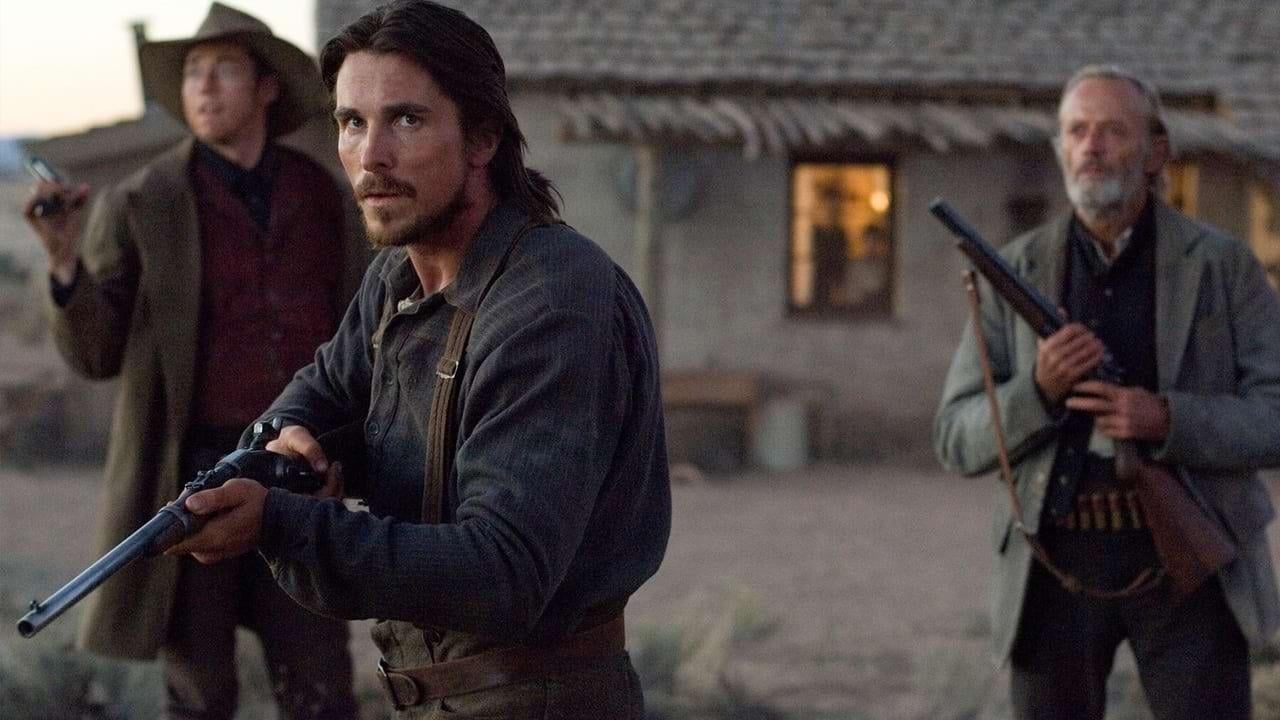
3:10 to Yuma — Unsafe Passage
Shot by Phedon Papamichael, ASC, this Western follows a desperate rancher’s attempt to bring a dangerous outlaw to justice.
Unit photography by Richard Foreman
This article was originally published in AC Oct., 2007. Some images are additional or alternate.
The “horse opera” was once a staple of Hollywood and the stock in trade of dozens of great ASC cinematographers, but today the Western remains a rare treat. This autumn promises to end the drought with 3:10 to Yuma, The Assassination of Jesse James by the Coward Robert Ford and No Country for Old Men.
The original 3:10 to Yuma was released by Columbia Pictures in 1957. Directed by Delmer Daves and photographed in black-and-white by Charles Lawton Jr., ASC, the film was based on an Elmore Leonard short story. Glenn Ford was cast against type as infamous outlaw Ben Wade, and Van Heflin played the proud but desperate Dan Evans, who volunteers to deliver Wade to the nearest train station in the hope of earning enough money to save his drought-stricken ranch. On the perilous journey to the final showdown, with Wade’s murderous gang in pursuit, Wade and Evans begin to earn each other’s respect.
“Regardless of genre, I don’t enjoy composing for 1.85 as much. I’m really comfortable with the wider frame, and I think it gives you much more space to play with.”
The recently released remake of 3:10 to Yuma reunited director James Mangold with cinematographer Phedon Papamichael, ASC, his collaborator on Walk the Line (see AC Dec. ’05) and Identity (AC May ’03). Papamichael likens the film, which stars Christian Bale as Evans and Russell Crowe as Wade, to a one-act play. “The characters reveal some interesting layers,” he says. “Wade likes to take chances and put himself in situations where he’s challenged almost out of boredom. His gang is totally focused and dedicated to him. When he’s captured, Evans just happens to be there, begging for an extension on his loan. Evans volunteers for the suicidal mission in part for the money, but also to earn the respect of his son, who is fascinated with Wade.”
“For day exteriors, we often weren’t even silking. The good thing about New Mexico in winter is that the sun is almost always low. There were usually too many characters to block the scene to the sun, and we were usually using multiple cameras.”
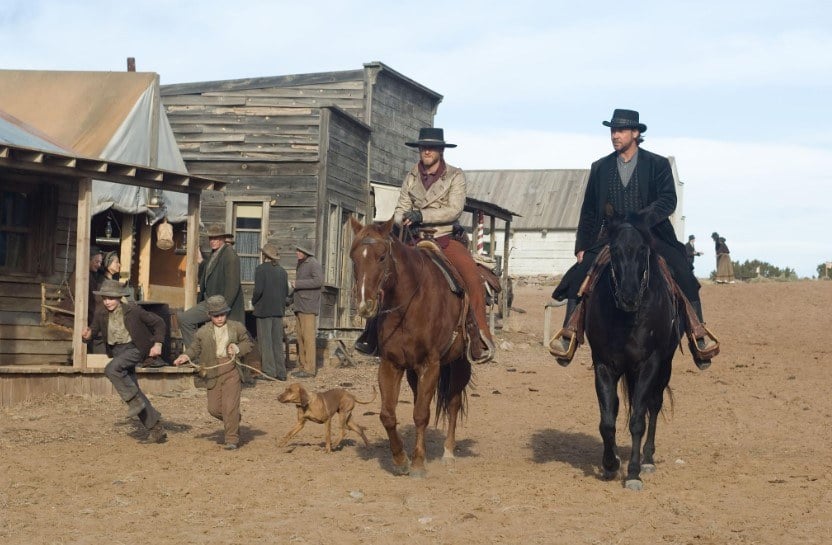
Principal photography took place in New Mexico, in and around Santa Fe, Abiquiu and Galisteo. The Bonanza Creek Ranch stood in for Contention, where the climactic shootout takes place, and Galisteo portrayed Bisbee, where Wade and Evans meet. The production constructed several additional buildings at the Cerro Pelon Ranch near Santa Fe. A few night exteriors were picked up back in Los Angeles at Bronson Canyon.
Throughout the project’s prep and production, the ability to adapt to changing circumstances was crucial to success. Originally budgeted at close to $100 million, the picture was put in turnaround by Sony Pictures and eventually passed off to Lionsgate. Soon the shoot was reconceived to suit a budget of about $50 million, and the new schedule, which totaled 54 days, was pushed into winter, so the filmmakers began working with roughly six hours of full daylight and many continuity challenges. After Christmas break, they returned to find their sets covered with deep snowdrifts.
The filmmakers chose to shoot Super 35 (2.40:1) and finish with a digital intermediate (DI), which they carried out at Modern VideoFilm in Burbank. “Regardless of genre, I don’t enjoy composing for 1.85 as much,” says Papamichael. “I’m really comfortable with the wider frame, and I think it gives you much more space to play with. Mangold loves doing the foreground close-up, with an actor’s face making up a quarter of the frame, and he loves the focus rack. We make extensive use of the close-focus [Panavision] Primo lenses. That’s become a bit of a trademark of ours.”
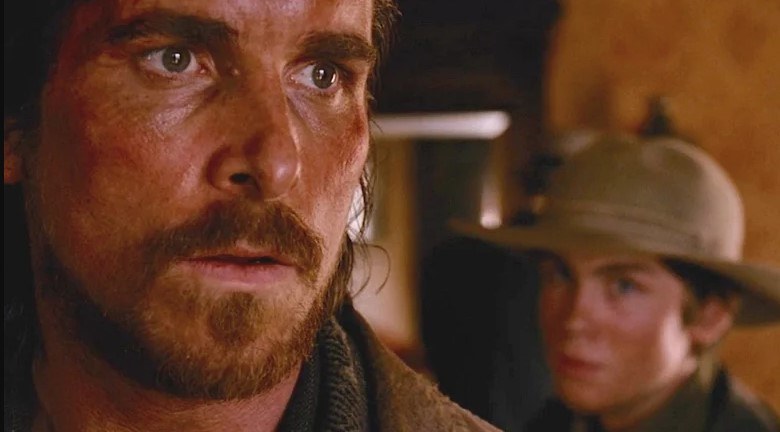
Papamichael shot the entire picture on two Fuji Eterna stocks, 250T 8553 and 500T 8573. “I try to stay away from very high- and low-speed stocks,” he notes. “I could have gone with a slower daylight film, but I don’t like the grain structure to change so much during the movie. I’m usually shooting at around a T2.8, but if I really need the extra stop I’d rather just open up.” His Panavision camera package comprised a Panaflex Platinum, two Millennium XLs, and Primo prime and zoom lenses.
Most scenes in 3:10 to Yuma fall into one of four situations: moonlit or firelit night exteriors, sunlit day exteriors, daylight interiors, and night interiors lit with oil lamps. As is typical of Westerns, day exteriors were predominant. Exteriors often included actors on horseback, which provided the crew with some rigging challenges. Papamichael’s instinct was to eschew electric sources whenever possible. “For day exteriors, we often weren’t even silking,” he says. “The good thing about New Mexico in winter is that the sun is almost always low. There were usually too many characters to block the scene to the sun, and we were usually using multiple cameras. We used Daylight Blue 12-by bounces to redirect and shape light.
“Often we weren’t designing shots carefully, but rather being flexible with the camera and just trying to get in there. You think you can control horses, but you can’t — they just don’t stand still. So Dave Luckenbach, my A-camera/ Steadicam operator, was constantly reacting [to their movements].”
“I was very much looking forward to the rare opportunity to shoot a Western.”
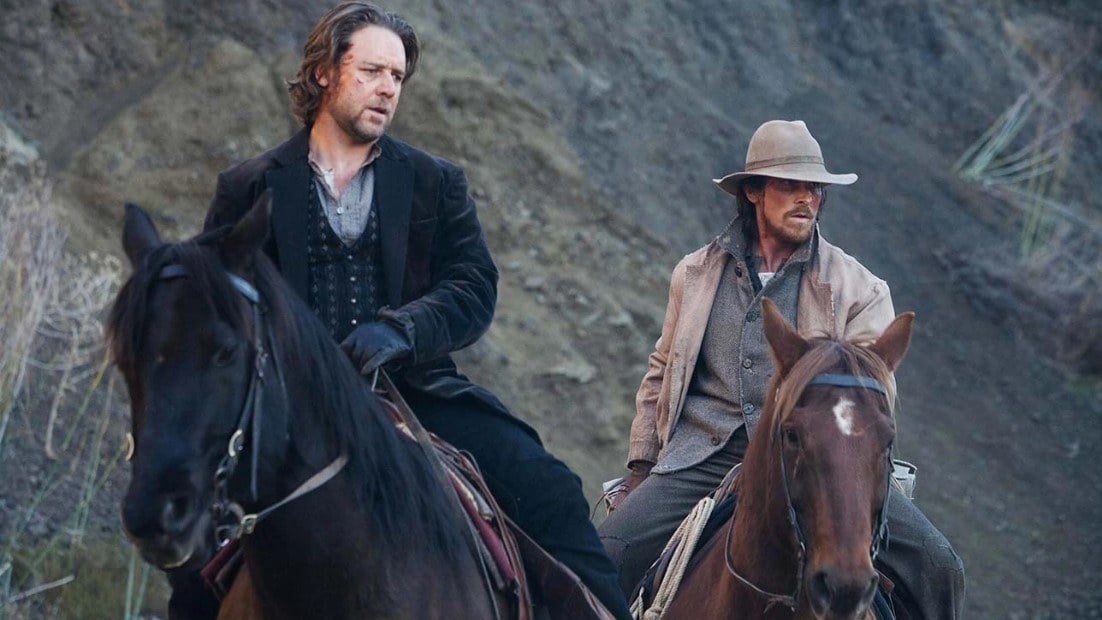
Day interiors in the saloon or hotel rooms were lit through windows. “Most of the third act takes place in a second-floor hotel room that was extremely small, for example, and sometimes we had eight actors in there,” says Papamichael. “The way it’s blocked, combined with our shooting style, which often involves someone turning into a tight close-up followed by a focus rack, meant that all the space was used up. Once you make the decision to bring all the light through the window, it becomes a matter of planning and shooting when the light is appropriate.”
The windows were covered with layers of hard ND gel that could be removed in stages to adapt to changing light levels outside. The ND was also used to create a dusk or dawn feel outside, even in broad daylight; the crew went as heavy as ND.27 to achieve that effect. “I also used negative fill on interiors, bringing blacks as close as possible to the action to model,” adds Papamichael. “Instead of adding light, I was removing ambiance. I did that when I was losing the sunlight and the contrast was disappearing.”
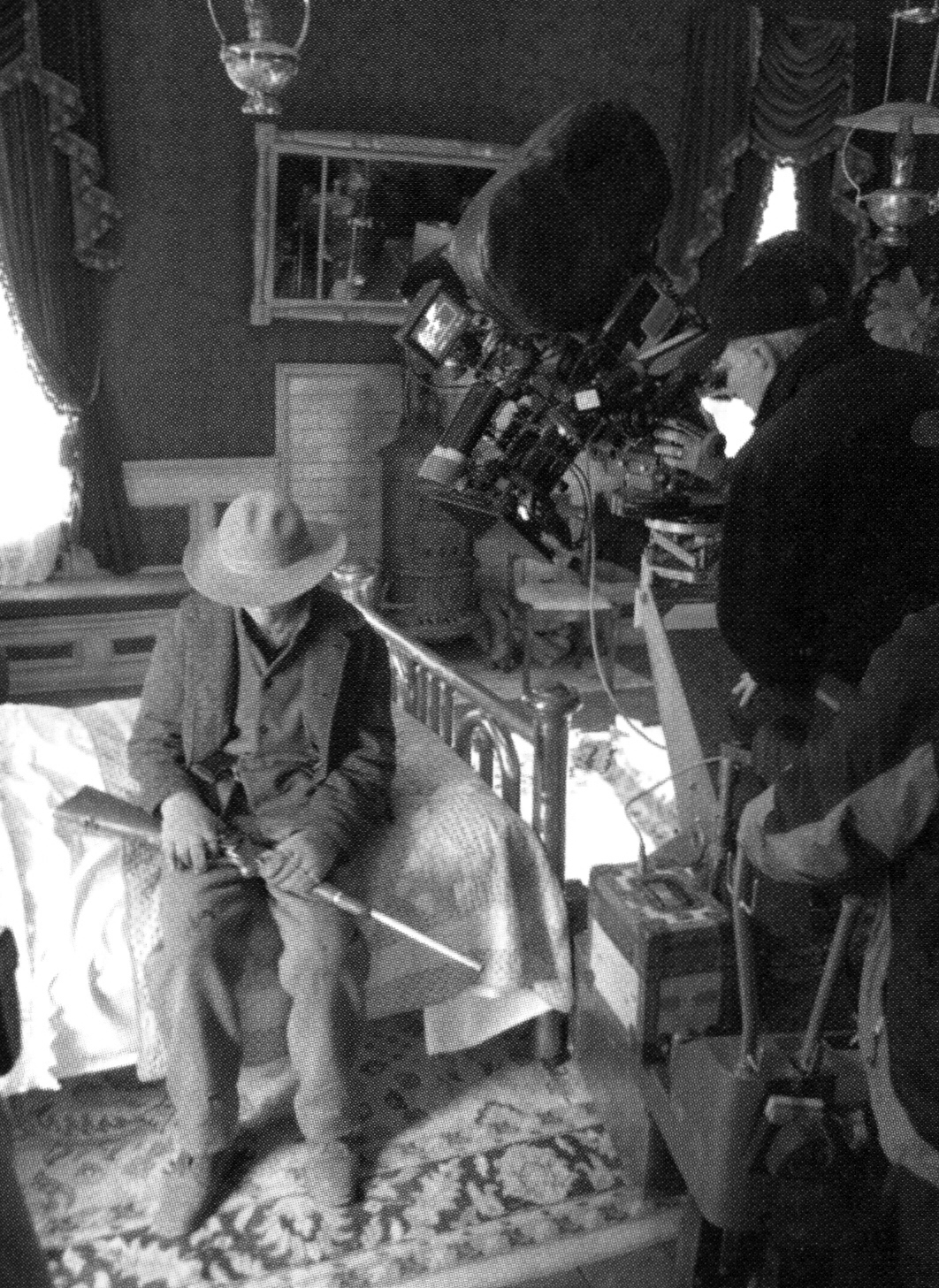
Often, Papamichael removed weather from the equation with a large, complex rigging job outside that was made more difficult by winter winds. The main day interiors were shot in a second-floor set, further complicating matters for the crew. The crew flew 20x20' and 40x40' blacks to eliminate or minimize direct sunlight inside, and then four or five 18Ks were sent up on Condors or scissor lifts. The 18Ks were usually brought through Opal or light Hampshire diffusion and ¼ CTS. This enabled the production to stretch six hours of daylight into 14-hour workdays.
Key grip Ray Garcia suggested Daylight Blue bounces, and Papamichael made extensive use of them throughout the shoot. “With New Mexico’s big, blue, open skies, those bounces made the light look much more natural,” he says. In exterior situations, Mangold often asked for tracking close-ups with the actors on horseback, sometimes with focus racks. The effects unit built a hydraulic rig with two saddles, but Crowe, an accomplished rider, didn’t care for it. On occasion, track was laid, but that was difficult and time-consuming. Papamichael originally planned to use an Ultimate Arm, but the project’s reduced budget precluded that option for the most part. In the end, the filmmakers used Gator Utility Vehicles in conjunction with the Steadicam, which didn’t quite allow for the height Papamichael would have preferred.
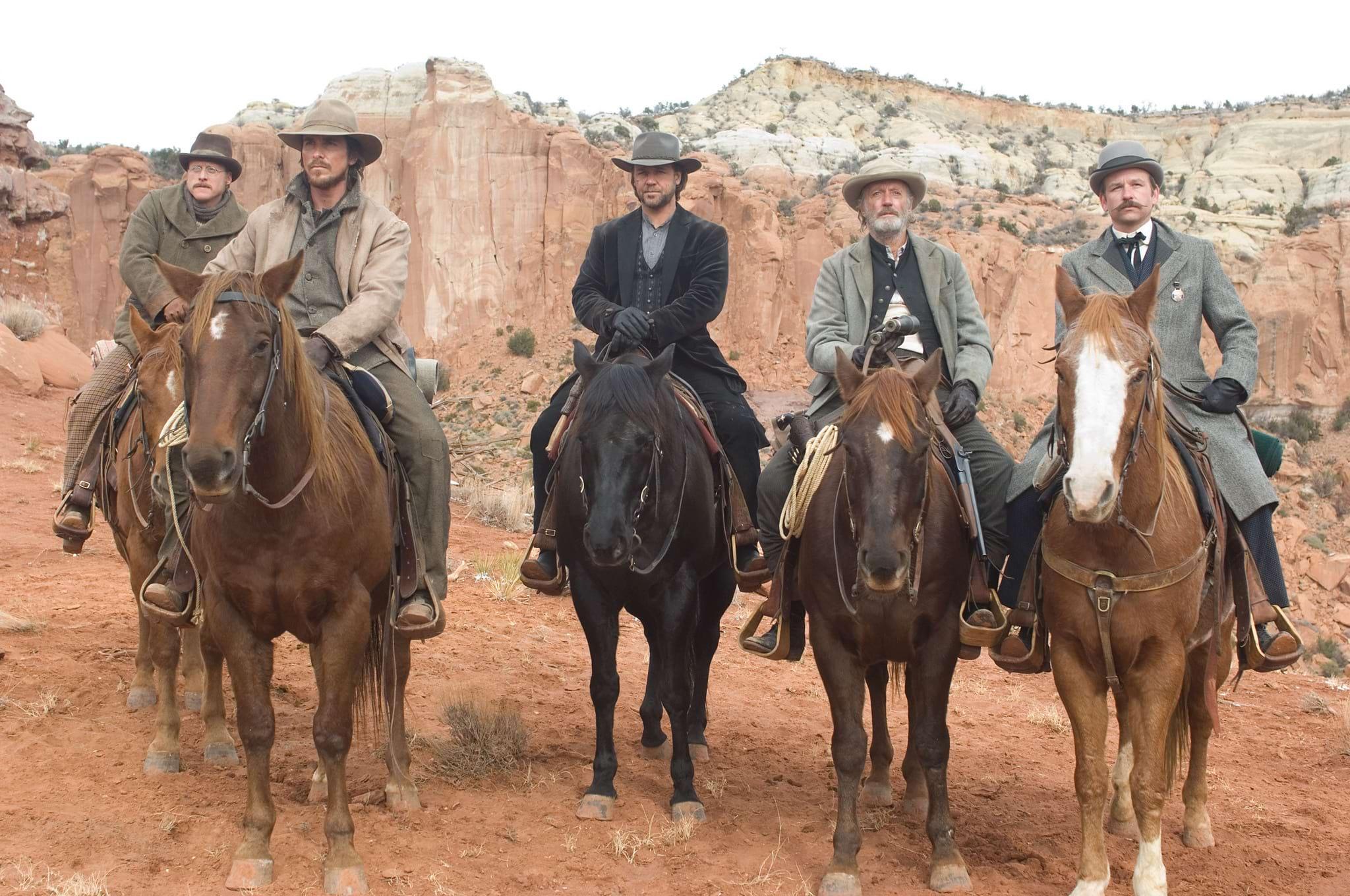
For moonlit exteriors featuring characters on horseback, Papamichael and his crew used a camera car with a truss hung with balloon lights that lit the actors with a soft, 3/4-toppy moonglow. Gaffer Cory Geryak recalls that the overhead helium-balloon rig allowed the horses to drift a bit and still stay within range of the light, which was important given the varied terrain. “The balloons were 8K tungsten tubes that were 12 feet long and 6 feet in diameter,” says Geryak. “There were four circuits, two per half, so we could turn sections off. We also had them on dimmers. I think we ended up going with just one circuit on each half of the balloon, so the full balloon was lit but to about half-intensity. The bulbs are actually quite small — eight 1Ks. They’re 220-volt, so the cables that go to the balloon are much smaller and lighter, which makes it easy to float the balloons. Ray Garcia devised the truss system to hold them, and it worked quite well. The natural variations in distance and movement of the horses made it difficult for the operators and the camera assistants, but it gave the shots a more organic and realistic feeling.”
The landscape in the deep background was raked with light from fixtures on Condors. “Bardwell & McAlister makes a 12-light MaxiBrute that we’ve fallen in love with for Condor work, because it’s really lightweight,” says Geryak. “I believe the head with the globes is about 45 pounds, and a traditional Nine-light Maxi is probably closer to 80 or 90 pounds. Another nice feature of these 12-lights is that they have interchangeable lenses instead of changeable globes; they use an HPL globe, the same technology as the Source Four Lekos. The different lenses give you different patterns of light, and a narrow lens is a very hot, punchy spot that’s good for distances. You can go from very narrow to narrow, medium or flood. We put three of those 12-light Bardwells in a Condor at each end of the canyon, along with a Mole Richardson 5K Par, and we were within the weight guidelines for Condor use. The 12- lights gave us a big, soft backlight, and the Par was perfect for picking out a ridge or gully.”
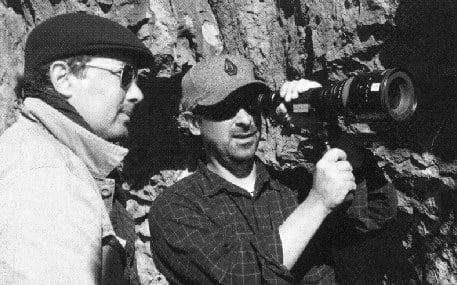
Papamichael needed a fine degree of control in order to balance the level in the foreground to that in the background. “When something looks ‘lit’ in this type of situation, it’s almost always because there’s a variance in level,” he notes. “The level of the background must be the same, because the moon is a very consistent source, like the sun. What I often see done wrong is that something in the deep, deep background will be hotter than the foreground. Of course, contrast comes from modeling and not using fill. But I find it’s key to have the same f-stop throughout the frame. The actor cannot have a hotter rim of moonlight than the ridge behind him, and vice versa.”
The filmmakers set a key campfire scene close to a sheltering canyon wall so the light could play against the rock wall, adding visual interest and placing the scene in an environment. “I like to do campfire light with as much real flame as possible, but if you have too many sources the light becomes even and you lose the individual flickers,” says Papamichael. “We used flame bars and other gags to boost the theatrical campfires, but I tried to use as few sources as possible. One character wears glasses, and on close-ups, you can see the flame reflected in the lenses!”
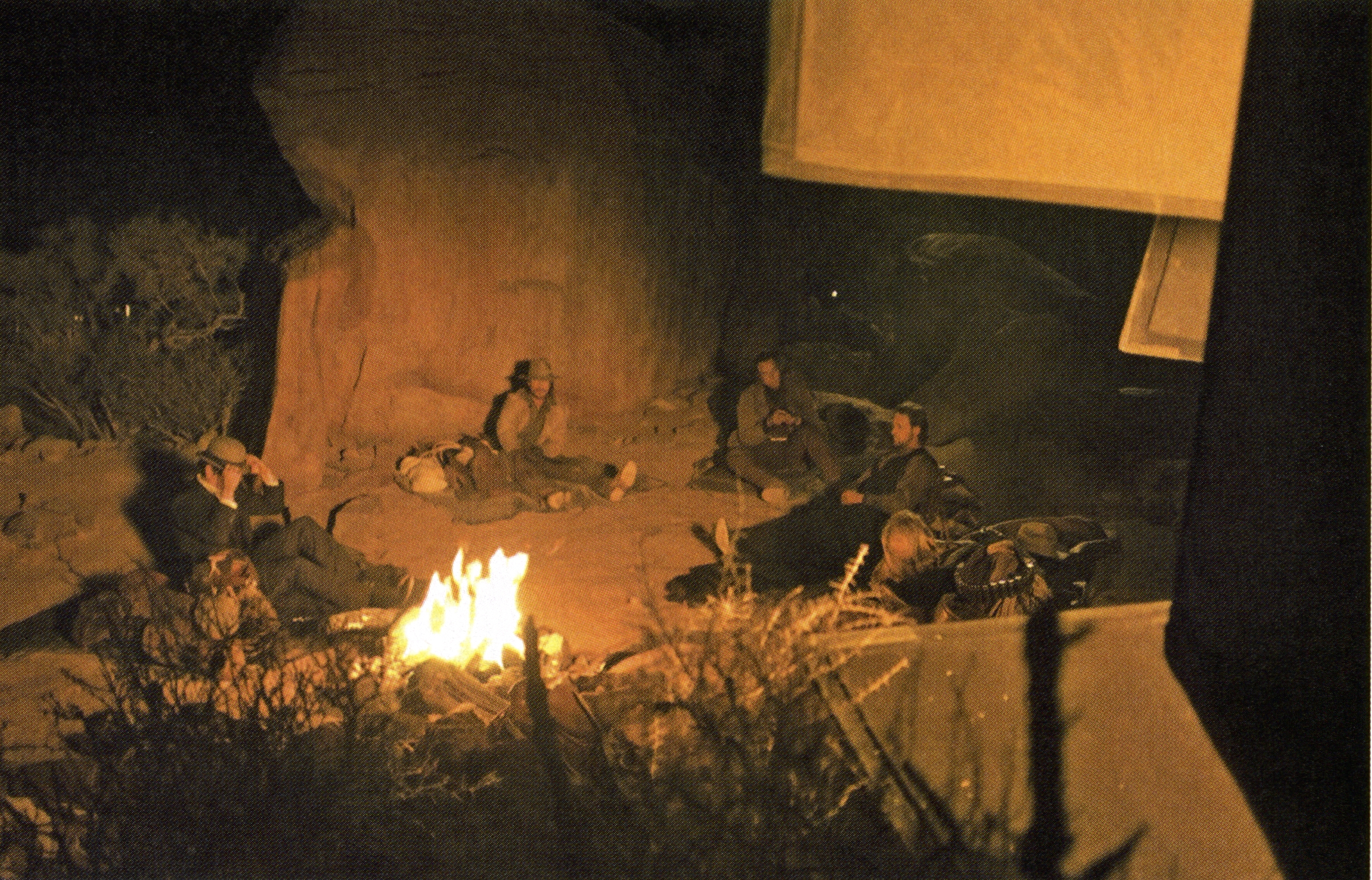
Some campfire shots were staged in a gymnasium in Santa Fe for greater control, and to escape the cold. At times the propane flame bars were augmented by a box that the crew referred to as the “Jell-O cube.” Geryak explains, “It’s a cube measuring 1 to 1½ feet that has six 650-watt globes inside. It uses a Socopex connection that allows us to control it using a programmable board. We have a little frame that we cover in Full Straw and either Opal or 250 diffusion to help slow it down. It’s the orange gel that makes it look like a Jell-O cube. We can bury it near the fire and it throws 360 degrees of light.”
Away from the firelight, the night exteriors fall off quickly to black. “I’ll only create visible moonlight if it’s the only source,” says Papamichael. “Moonlight does read to your eye, and it’s very hard light.
But the minute you turn on one 20-watt bulb, that will overpower the moonlight. I would motivate from moonlight, but only if the actors were riding out in the open and there were no other sources. If there was a single torch or a campfire, I might put the moonlight 2½ or 3 stops under so it’s not just orange and black. It might not be a complete absence, but you perceive it as such. I think your eye needs a neutral tone in order to identify the flame source as warm and saturated, but it’s very subtle.”
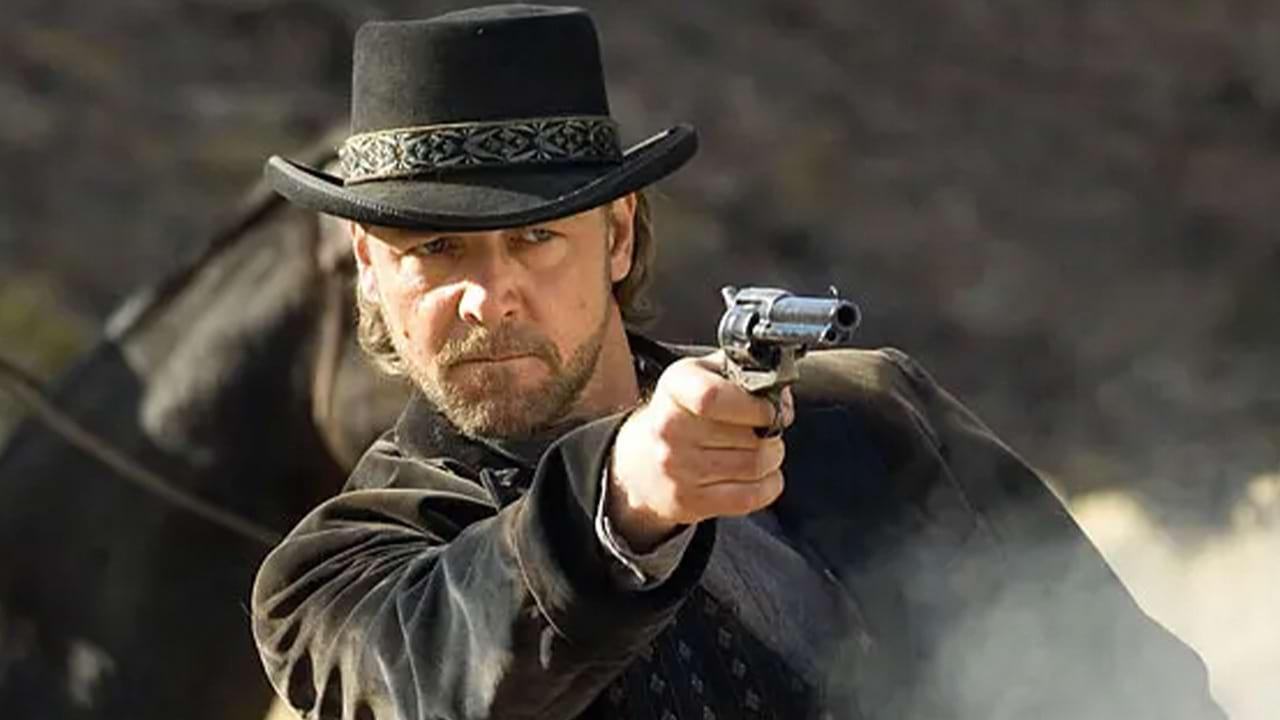
Papamichael avoided setting multiple lights for a moonlit scene, but the wide-brimmed cowboy hats sometimes required light from below the eyeline. “I would sometimes do a passive bounce to pick up the eyes, especially when the characters were wearing wide-brimmed hats,” he says. “Cory would often handhold the battery-powered Litepanels LED light, but it was filling at 3 stops under and didn’t read as another source. There’s only one moon, and I tried to stay true to that.”
When possible, Papamichael captured night exteriors at late dusk. “We’d wait for the very last light. After the sun sets, you have maybe a 20-minute window when there’s still some definition and blue in the sky; the meter reads 1 or maybe 1.4 when you point it up to the sky. Then I would usually bounce a very big soft source into a frame of Daylight Blue to create a very, very low fill, as though it was coming off the sky. We’d use floating nets so the light wouldn’t increase in intensity when the actors moved closer. In these situations, it’s all about not feeling the source.”
3:10 to Yuma includes a few night interiors that made extensive use of a lantern rig Geryak devised for Wally Pfister, ASC on The Prestige (AC Nov. ’06). “In our testing, we found that the flame in oil lamps doesn’t move all that much,” says the gaffer. “We took a 650-watt tungsten globe that was just the right size to fit into the base of the oil lantern. The filament looked like the right height of an oil flame. Then we dimmed it down to about 30 volts. It burns just hot enough that you can’t tell it’s not real fire, and it comes out to the same color temperature as an oil lamp, around 2100°K. It blooms out and hides itself. If we get really tight to it with the camera, we’ll frost the glass a bit to keep it obscured.” For interiors, Papamichael also depended heavily on rope lights mounted on boards in various configurations. “The advantage of rope lights is that they’re very low-profile and can be easily hidden on small sets,” he says. “They’re lightweight, easy to move, and you can just lay them on a surface or prop them up against an apple box. They wrap nicely. Often we just handheld them. They produce a beautiful, natural light that’s about 2000°K; they photograph at about the same color temperature as the little gas lanterns.”

Because darkness was an important component of the visual scheme, wardrobe and other design elements were controlled and low-key. Walls were kept somewhat dark and sometimes lined with wood paneling. “That gave me a little more freedom from worrying about walls heating up too much,” says Papamichael. “When I push light through windows, I always keep an eye on the walls to make sure they’re not too flooded. We do a lot of grip work and cut a lot of light to control that. I’d say the biggest part of my lighting is eliminating light! That’s where the DI has become a direct extension of what we do on the set. I use the DI quite a bit to control and shape light.”
Papamichael’s collaborator at Modern VideoFilm was colorist Joe Finley, who had also worked with him on Walk the Line. The film was finished with a 2K workflow to save money in the post-phase. “It was a pretty quick process, about eight days,” says Papamichael. “Joe is very familiar with our aesthetic and is able to do an overall timing on his own. Mangold and I then tweak, and I’m able to build some windows, control some skies and work on the matching. We worked with a 2K projector, but we did occasional filmouts, which I enjoyed. When you get a little bit of that film texture back, the picture gains something emotionally.”
Throughout the shoot, FotoKem developed and transferred more than a million feet of film, using digital stills Papamichael had shot on set and manipulated in Photoshop as a rough guide for saturation, contrast and density. The filmmakers viewed hi-def dailies on D-5 tape that had been transferred by Kay Sievert using the Millennium telecine and Avid’s DNX115 codec. “When you’re shooting a Western, I think it’s important that the editor is looking at something a little bigger to cut with,” says Papamichael. “Our editor, Mike McCusker, worked with a good quality DLP projector in the editing room. He was also able to do some rough preliminary timing in his Avid. The image quality was pretty high right from the dailies stage.
“I was very much looking forward to the rare opportunity to shoot a Western,” concludes Papamichael, “but this film isn’t a Western in the classical sense. It’s not about the land and the landscapes, it’s more about faces and dialogue and strong characters. It plays more as a modern psychological Western drama. Every time you make a movie, you go in with a certain concept, but the movie ends up telling you what the visual language should be. 3:10 to Yuma was another example of that.”
The cinematographer and director later collaborated on features including Knight and Day, Ford v Ferrari and Indiana Jones and the Dial of Destiny. Papamichael’s other credits include Sideways, Nebraska, Downsizing and The Trial of the Chicago 7.
If you enjoy archival and retrospective articles on classic and influential films, you'll find more AC historical coverage here.
Access the every issue of AC and every story from more than the last 100 years with our Digital Edition + Archive subscription.
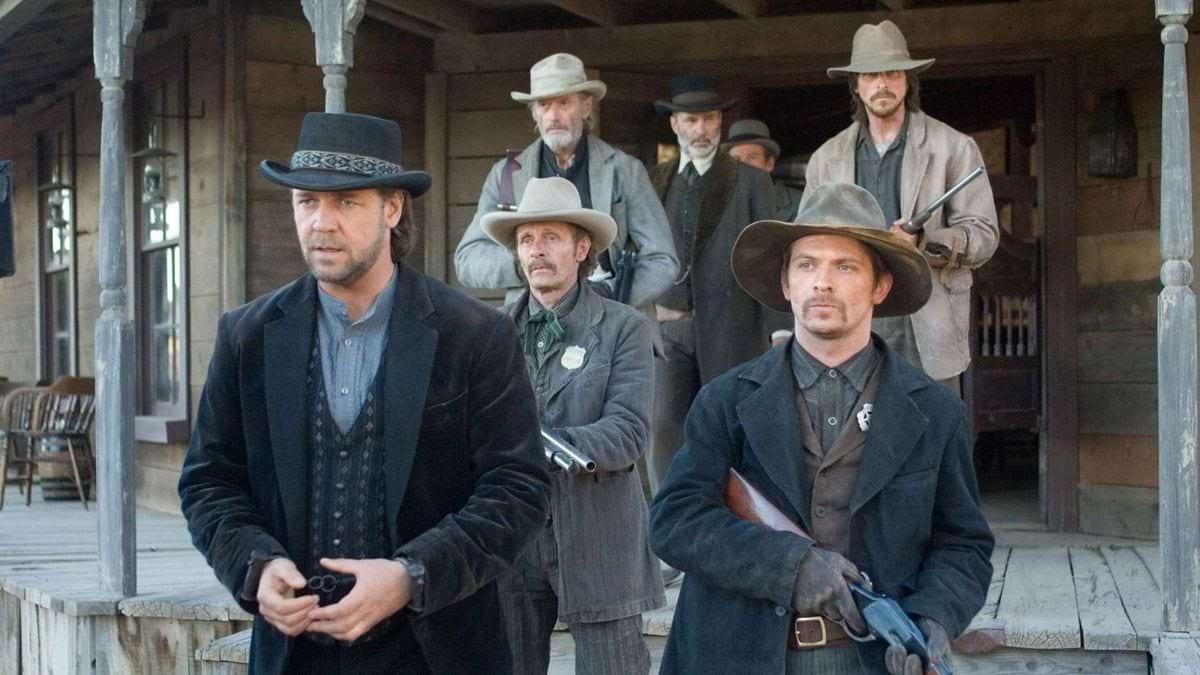
TECHNICAL SPECS
2.40:1
Super 35mm Panaflex Platinum
Millennium XL Primo lenses
Fuji Eterna 250T 8553, 500T 8573
Digital Intermediate
Printed on Fuji Eterna-CP 3513DI






